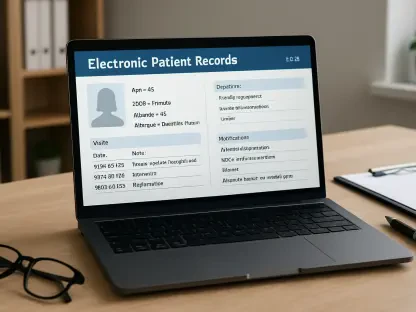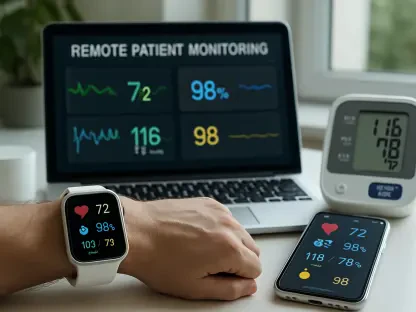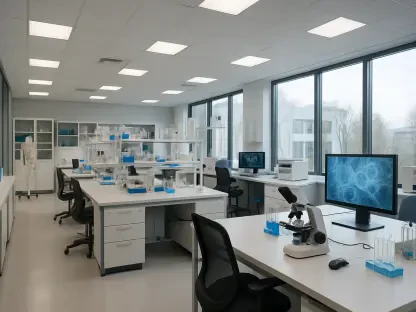In the fast-evolving world of healthcare, where data drives decisions, a persistent hurdle remains: a vast amount of critical information in electronic health records (EHRs) is locked away in unstructured free-text notes, making it challenging for clinicians to access vital details swiftly and efficiently during patient care. This gap not only slows down clinical workflows but also poses risks to patient safety by obscuring key insights needed for timely interventions. MiADE (Medical Information AI Data Extractor), an innovative natural language processing (NLP) system, steps into this breach with a groundbreaking approach, transforming messy narrative text into structured, actionable data right at the point of care. Deployed at University College London Hospitals (UCLH) in the UK, MiADE integrates seamlessly with the Epic EHR system, extracting essential clinical elements like diagnoses, medications, and allergies for clinician validation. Unlike traditional NLP tools that focus on historical data analysis, this system operates in real time, offering immediate value during active patient encounters. Built on the robust MedCAT library, it identifies medical terms and links them to standardized terminologies like SNOMED CT, ensuring consistency and usability across platforms.
The promise of MiADE lies in its ability to enhance the completeness of EHR data while reducing the administrative burden on healthcare providers, allowing doctors to prioritize patient interaction over tedious data entry. By automating the extraction process, it reshapes clinical workflows for the better, offering a transformative approach to medical documentation. Early results from UCLH deployments suggest significant time savings and practical applicability, though the journey is far from complete. As an open-source, modular solution, MiADE holds the potential to adapt to diverse healthcare settings, addressing a universal challenge in medical documentation. This exploration delves into the system’s design, performance, and real-world impact, shedding light on how it navigates the complex intersection of technology and patient care.
Understanding the Need for Structured Data in EHRs
The Critical Role of Organized Information
Structured data within EHRs serves as the backbone of modern healthcare delivery, enabling automated alerts for life-saving interventions such as medication allergy warnings and reminders for chronic condition follow-ups like diabetes or hypertension management. Without this organized format, crucial patient details remain buried in narrative text, increasing the likelihood of missed information during critical moments of care. An audit conducted at UCLH during the height of the COVID-19 crisis exposed the severity of this issue, revealing that only 62% of inpatient diagnoses were documented in structured problem lists. This significant shortfall in data completeness can directly undermine patient outcomes, especially during transitions of care where clear records are vital. Structured data also plays a pivotal role in supporting broader healthcare goals, from facilitating large-scale research to enabling population health initiatives that rely on standardized, easily accessible information.
Beyond immediate clinical applications, the absence of structured data hampers the ability to leverage advanced analytics and artificial intelligence for personalized medicine and quality improvement audits, creating significant challenges for healthcare innovation. When information remains in free-text form, it demands labor-intensive manual processing to extract meaningful insights, often delaying actionable results. The push for structured records aligns with national healthcare guidelines advocating for standardized terminologies to ensure consistency across systems. Yet, the reality on the ground shows that achieving this level of organization is no small feat, given the inherent complexities of clinical documentation and the diverse needs of healthcare providers navigating high-pressure environments.
The Strain of Manual Documentation
The process of converting clinical observations into structured data places a heavy burden on clinicians, often pulling their attention away from direct patient engagement during consultations. Manually entering information using intricate coding systems like SNOMED CT can be a cumbersome task, especially when EHR interfaces lack intuitive design or require navigation through dense terminology browsers mid-interaction. This not only disrupts the flow of patient-provider communication but also contributes to clinician burnout, as time spent on administrative tasks overshadows the core mission of caregiving. National standards emphasize the importance of structured records for enhancing care continuity, yet the practical challenges of implementation often result in incomplete documentation, with critical details left in unstructured narratives.
Moreover, the time constraints of busy hospital settings exacerbate these documentation challenges, leaving many healthcare providers with little choice but to prioritize immediate patient needs over thorough data entry. This trade-off, while understandable, perpetuates a cycle where incomplete or inaccessible data undermines downstream processes like clinical decision support and research. The frustration of wrestling with clunky systems is a common thread among clinicians, highlighting a pressing need for solutions that streamline this process without sacrificing accuracy. Addressing this gap is essential not just for individual patient safety but also for the broader efficacy of healthcare systems reliant on comprehensive, structured information to drive better outcomes.
The Role of NLP in Real-Time Clinical Settings
Converting Text to Actionable Insights
Natural language processing (NLP) emerges as a powerful ally in the quest to transform unstructured clinical text into structured, usable data, directly addressing the inefficiencies of manual documentation within EHRs. Unlike the majority of NLP applications that focus on retrospective analysis of historical records for research purposes, point-of-care NLP systems like MiADE operate in the immediacy of clinical encounters, processing notes as they are written or shortly thereafter. This real-time functionality offers a significant advantage by providing clinicians with structured data suggestions for review right within their existing EHR workflows, eliminating the need for additional tools or interfaces. By automating the extraction of key clinical entities such as diagnoses or medications, this approach aims to reduce the cognitive load on healthcare providers, allowing them to maintain focus on patient interaction while ensuring critical information is captured accurately.
The potential of real-time NLP lies in its ability to bridge the gap between the narrative style of clinical notes and the structured formats needed for decision support systems. For instance, identifying a mentioned allergy or condition in free text and linking it to a standardized code can trigger immediate alerts or reminders during a consultation, enhancing patient safety on the spot. The integration of such technology into daily practice represents a shift toward proactive data management, where information is not just recorded but actively utilized to inform care decisions. While the concept is promising, the success of this transformation hinges on the system’s ability to interpret complex medical language accurately and present suggestions in a way that complements, rather than disrupts, clinical routines.
Exploring the Evidence and Remaining Challenges
Although the field of real-time NLP in healthcare is still emerging, early studies provide a glimpse into its potential to revolutionize clinical documentation by saving time and boosting data entry efficiency. Projects at institutions like Brigham and Women’s Hospital have demonstrated tangible benefits, such as quicker identification of patient allergies within EHR systems, paving the way for broader exploration of point-of-care applications. MiADE builds on these foundations by targeting a range of clinical concepts, including diagnoses, medications, and allergies, with the goal of proving that automation can enhance decision-making without introducing unnecessary friction into clinical workflows. The hypothesis driving such initiatives is that by embedding NLP directly into the care process, healthcare providers can achieve higher data completeness, ultimately improving patient outcomes and operational efficiency.
However, the body of research on point-of-care NLP remains limited compared to its retrospective counterpart, leaving significant gaps in understanding its full effectiveness, optimal configurations, and long-term impact on clinician satisfaction. Challenges such as ensuring the accuracy of extracted data amidst the nuances of medical jargon and varying documentation styles pose hurdles that require ongoing refinement. MiADE’s deployment at UCLH serves as a critical testbed for addressing these unknowns, offering real-world insights into how such systems perform under the pressures of live clinical settings. The journey to widespread adoption will depend on accumulating robust evidence that balances the benefits of automation with the imperative of maintaining clinical accuracy and trust in AI-driven suggestions.
Inside MiADE: Design and Functionality
Building a Flexible Framework
MiADE stands out with its thoughtfully engineered architecture, designed to prioritize adaptability and seamless integration across diverse EHR environments, ensuring it can meet the varied needs of healthcare institutions. As an open-source, modular system, it avoids the constraints of a proprietary user interface, instead communicating directly with EHR platforms like Epic at UCLH through standardized HL7 messaging protocols, with potential for future alignment with FHIR standards. This approach allows for compatibility with existing hospital systems, reducing the learning curve for clinicians accustomed to their current tools. The system’s core components work in concert to process clinical notes effectively: section detection identifies relevant headers within texts, named entity recognition (NER) powered by the MedCAT library pinpoints clinical terms, and context analysis via MetaCAT filters for relevance, ensuring that only meaningful suggestions reach the clinician for review.
The modular nature of MiADE’s design not only facilitates customization to local EHR configurations but also supports scalability, allowing for updates and enhancements as technology and clinical needs evolve. For example, section detection relies on configurable patterns to recognize structured elements like “Problem List” in notes, which enhances the accuracy of data extraction by focusing on organized content over narrative prose. This layered pipeline reflects a deliberate strategy to refine outputs at each stage, minimizing errors before they reach the end user. By embedding flexibility at its core, MiADE positions itself as a versatile solution capable of addressing the fragmented landscape of healthcare IT systems, where no two hospitals operate identical setups, thus paving the way for broader adoption.
Crafting Precision Through Robust Training
The effectiveness of MiADE hinges on its extensive training process, which leverages vast datasets to ensure accurate interpretation of complex clinical language across varied documentation styles encountered in real-world settings. Drawing from a corpus of 800,000 clinical notes from UCLH, the system underwent unsupervised learning to grasp contextual nuances, while supervised annotations by health informaticians refined its ability to recognize synonyms and disambiguate terms. This dual approach was critical for tailoring MiADE to specific domains like discharge summaries, which are pivotal for care transitions and clinical coding. Additionally, synthetic data generation addressed imbalances in rare contexts—such as negated or suspected diagnoses—enhancing the model’s robustness by simulating diverse linguistic patterns that might not appear frequently in natural datasets.
To further sharpen its focus, MiADE employs customized concept databases for diagnoses, medications, and allergies, deliberately excluding irrelevant or overly broad terms to prevent cluttering outputs with non-actionable suggestions. For instance, the diagnosis database omits family history or normal findings, zeroing in on symptoms and disorders that matter most to clinicians. A dedicated dashboard tool also aids in managing training data and visualizing performance metrics, allowing developers to iteratively improve the system based on real-time feedback. This meticulous preparation underscores a commitment to precision, ensuring that MiADE not only detects clinical entities but also interprets them in a way that aligns with the practical needs of healthcare providers, thereby fostering trust in its automated outputs.
Performance and Clinical Impact
Evaluating Effectiveness Through Metrics
MiADE’s performance has been rigorously assessed through targeted testing, yielding encouraging results that highlight its potential to transform clinical documentation by extracting structured data with notable accuracy. When evaluated on a set of 50 double-annotated discharge summaries at UCLH, the system achieved a precision of 83.2% and a recall of 85.2% for detecting diagnoses, resulting in a strong F1 score of 0.84—a metric that balances both precision and recall to gauge overall effectiveness. These figures suggest a high level of reliability in identifying key clinical entities from unstructured text. However, context detection proved more challenging, particularly in narrative prose, where precision dipped due to the complexities of interpreting free-form language. As a result, the production configuration was adjusted to prioritize concepts within structured note sections, such as under specific headings like “Diagnoses,” to maximize accuracy.
Beyond raw metrics, simulation testing with a small group of clinicians provided deeper insight into MiADE’s practical value, revealing an impressive 89% reduction in the time required to enter structured problem lists compared to the standard Epic EHR interface. This substantial time saving points to significant potential for enhancing workflow efficiency, allowing healthcare providers to allocate more focus to direct patient care rather than administrative tasks. Nevertheless, translating these controlled test results into real-world settings introduces variables like text variability and user adaptation, which necessitate continuous monitoring. The early data paints a promising picture, but sustained evaluation is crucial to confirm that these gains hold under the unpredictable conditions of daily clinical practice.
Real-World Deployment and Early Insights
Since going live at UCLH in February 2024, MiADE has demonstrated its feasibility in active clinical environments, processing over 1,600 documents and extracting 317 concepts across 111 patient records in its initial months of operation. This early adoption reflects a growing acceptance among trial users, suggesting that the system can integrate into busy hospital workflows without causing major disruptions. The ability to handle real-time data extraction during patient care marks a significant step forward, as it directly contributes to building more complete EHRs while minimizing manual effort. Although comprehensive evaluation results are still pending, the absence of immediate setbacks in live settings offers a positive indication of MiADE’s practical applicability and its capacity to support clinicians under real-world pressures.
Further examination of these initial outcomes reveals the importance of clinician engagement in ensuring the system’s success, as their validation of extracted concepts remains a critical safeguard against potential errors. The focus during this phase has been on refining integration and gathering feedback to enhance user experience, particularly in how suggestions are presented within the Epic interface. While the numbers indicate a solid start, the broader impact on data quality and clinician satisfaction requires longer-term analysis to fully understand how MiADE influences care delivery. These early steps lay a foundation for iterative improvement, highlighting the need for ongoing adjustments to align the technology with the dynamic demands of clinical environments and diverse patient cases.
Challenges in Integration and Deployment
Navigating Technical Complexities
Integrating MiADE with the Epic EHR system at UCLH presented a host of technical challenges, underscoring the often-overlooked friction between standardized protocols and the realities of local hospital IT configurations. Discrepancies in how EHR systems are tailored to specific institutional needs meant that standard HL7 templates frequently did not align with on-the-ground setups, necessitating extensive reverse-engineering and close collaboration with hospital IT teams to ensure compatibility. Deployment on internal networks further required meticulous testing in non-live environments to simulate real usage, including load testing for up to 100 concurrent users to guarantee performance under peak demand. Adherence to stringent NHS digital safety standards added another layer of complexity, as every aspect of the system needed to meet rigorous benchmarks to protect patient data and system integrity.
These interoperability hurdles reflect a broader challenge within healthcare technology, where theoretical standards often fall short when confronted with the practical variations of individual hospital systems. The time and resources devoted to troubleshooting integration issues highlight the importance of anticipating such obstacles in the design phase of any AI-driven tool. Beyond technical alignment, ensuring secure communication over HTTPS and maintaining data privacy during transmission were paramount concerns that shaped the deployment strategy. Addressing these complexities is not just a matter of technical prowess but also of fostering partnerships between developers and hospital stakeholders to navigate the intricate landscape of healthcare IT infrastructure effectively.
Balancing Safety and Scope Constraints
Ensuring clinical safety during MiADE’s rollout was a top priority, with comprehensive hazard workshops conducted to identify potential risks such as software failures, integration glitches, or the danger of clinicians overly relying on NLP-generated suggestions without sufficient scrutiny. A detailed clinical safety case was developed to mitigate these concerns, outlining protocols to manage identified risks and ensure patient well-being remained uncompromised. This cautious approach influenced the scope of the initial deployment, which was limited to diagnoses due to unresolved integration challenges for medications and allergies. Such a phased implementation reflects a deliberate strategy to prioritize reliability over breadth, allowing for focused testing and refinement before expanding the system’s capabilities to other clinical domains.
This emphasis on safety also underscores the reality that full-scale deployment of AI tools in healthcare is an iterative process, often requiring multiple cycles of adjustment to address unforeseen issues. Limiting the initial rollout provided an opportunity to gather targeted feedback on diagnosis extraction, helping developers fine-tune algorithms and integration processes before tackling more complex data types. The necessity of clinician validation at every step further reinforces the importance of maintaining human oversight, ensuring that automation serves as a support mechanism rather than a replacement for professional judgment. These constraints, while slowing the pace of expansion, are essential for building trust in the technology and ensuring that patient care remains the ultimate focus amid the push for innovation.
Looking Ahead: Future Potential of NLP in Healthcare
Overcoming Current Limitations
Reflecting on the journey of MiADE at UCLH, the system carved a notable path in tackling the pervasive issue of unstructured EHR data, achieving early success by processing thousands of documents and demonstrating substantial time savings in controlled simulations. The integration into live clinical workflows since early 2024 marked a significant milestone, with initial usage data indicating that the technology could operate effectively within the demanding pace of hospital settings. Challenges in context detection and local EHR configurations were met with strategic adjustments, such as focusing on structured note sections to enhance accuracy, while a clinician-in-the-loop model ensured that safety was never compromised. This cautious yet innovative approach laid crucial groundwork for understanding how NLP could reshape point-of-care documentation in practical, real-world scenarios.
The deployment faced technical hurdles that were navigated through rigorous testing and collaboration with IT teams, highlighting the importance of adaptability in healthcare technology. While the scope was initially narrowed to diagnoses due to integration complexities, this phased rollout allowed for targeted improvements and built a foundation of trust among users. The performance metrics, with high precision and recall for diagnosis detection, underscored the system’s potential to alleviate manual data entry burdens. Looking back, these early efforts provided valuable lessons on balancing automation with clinical oversight, setting a precedent for how AI tools could be responsibly embedded into sensitive healthcare environments.
Envisioning Broader Horizons
Moving forward, the next steps for MiADE involve expanding its capabilities to encompass real-time suggestions during note entry, potentially integrating advanced large language models (LLMs) to improve context reasoning and capture intricate clinical relationships beyond basic SNOMED CT codes. Exploring cross-center model performance will be vital to ensure the system’s effectiveness across diverse healthcare settings, addressing variations in documentation styles and patient populations. Standardized interoperability solutions, perhaps through wider adoption of FHIR protocols, could streamline future integrations, reducing the friction encountered with local EHR configurations. These advancements aim to build on the solid base established at UCLH, pushing the boundaries of what point-of-care NLP can achieve.
Additionally, fostering clinician feedback loops will remain essential to refine user interfaces and enhance trust in automated outputs, ensuring that suggestions align seamlessly with clinical workflows. Investment in broader testing and collaboration with other institutions could unlock new insights into scalability and customization needs, paving the way for MiADE to serve as a blueprint for global healthcare systems grappling with data challenges. Encouraging open-source contributions may further accelerate innovation, allowing developers worldwide to tailor the system to unique contexts. As the field of healthcare informatics evolves, prioritizing these actionable steps will help solidify NLP’s role as a transformative force, ultimately driving better patient outcomes through smarter, more accessible data management.









